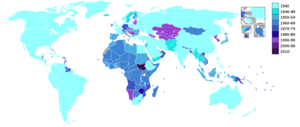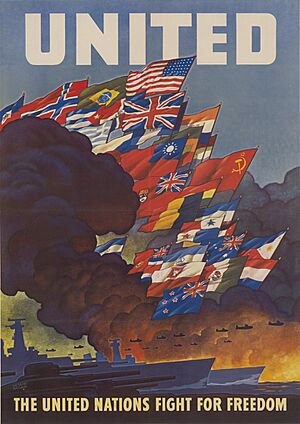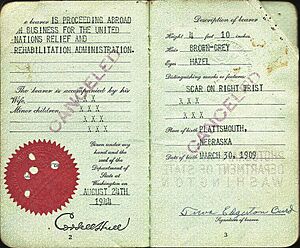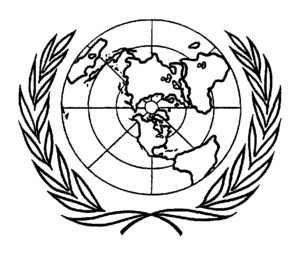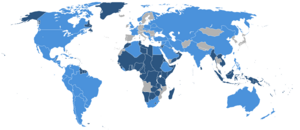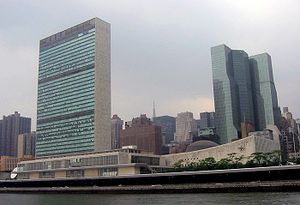History of the United Nations facts for kids
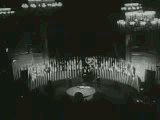
The history of the United Nations began during World War II. It started with leaders thinking about how to prevent future wars. US President Franklin D. Roosevelt wanted to create a new organization. This organization would replace the League of Nations, which had not been successful. Roosevelt imagined that the United States, the Soviet Union, the United Kingdom, and China would lead this new group. These "Big Four" would work together to solve major world problems. Since then, the UN's goals have grown. It has become a very important international group in the 21st century.
Contents
Early Ideas for Global Cooperation
Before the UN, countries started working together on specific issues. For example, the International Telegraph Union began in 1865. The Universal Postal Union started in 1874. Both of these groups are now part of the United Nations. In 1899, the Permanent Court of Arbitration was created. This court helps countries settle disagreements peacefully.
After World War I, the League of Nations was formed in 1919. Its goal was to encourage countries to cooperate and keep peace. The League had different parts, like an Assembly and a Council. It also had a court to handle international legal cases. The International Labour Organization, which helps workers worldwide, was also created then. It is now a special agency of the UN.
How the UN Began
The idea for the UN grew from several meetings and agreements during World War II.
The London Declaration: A First Step
On June 12, 1941, representatives from many countries met in London. These included the United Kingdom, Canada, Australia, and several governments exiled from countries occupied by enemy forces. They signed the Declaration of St James's Palace. This declaration shared a vision for a peaceful world after the war. It was an important first step towards creating the United Nations.
Soon after, from August 9-12, 1941, US President Franklin Roosevelt and British Prime Minister Winston Churchill met. They wrote down their vision in more detail in the Atlantic Charter. Later, on September 24, 1941, other countries, including the Soviet Union, agreed to these principles.
Naming the "United Nations"
President Roosevelt first suggested the name "United Nations." He used it to describe the countries fighting together in World War II. Prime Minister Churchill liked the idea. He remembered the phrase from a poem about the Allies at the Battle of Waterloo.
The "Declaration by United Nations" was written by Roosevelt, Churchill, and Roosevelt's aide Harry Hopkins. This happened in December 1941. It included ideas from the Soviet Union. On January 1-2, 1942, 26 governments signed this declaration. A key change from the Atlantic Charter was adding a promise for religious freedom. This was important to Roosevelt.
The declaration stated that the signing governments:
- Agreed to the principles of the Atlantic Charter.
- Believed that winning against their enemies was vital to protect life, freedom, and human rights.
- Pledged to use all their resources against the enemy forces.
- Promised to work together and not make separate peace agreements.
During the war, "United Nations" became the official term for the Allies. To join, countries had to sign this declaration and declare war on the enemy powers.
Planning for a New World Body
Leaders made their first promises to create a new international organization in 1943. This happened at wartime meetings of the Allies.
At the Quebec Conference in August 1943, US Secretary of State Cordell Hull and British Foreign Secretary Anthony Eden agreed on a plan. They wanted a "general international organization" where all nations were equal.
President Roosevelt also promoted the idea of "Four Policemen." These would be the United States, Britain, the Soviet Union, and China. They would work together to keep peace. The Moscow Conference in October 1943 led to the Moscow Declarations. These included the "Declaration of the Four Nations on General Security." This declaration officially announced plans for a new international organization. It would replace the old League of Nations.
Later, Roosevelt, Churchill, and Stalin discussed this idea further at the Tehran Conference.
Shaping the UN: Key Meetings
The Allies agreed on the basic structure of the new organization at the Dumbarton Oaks Conference in 1944. Delegations from the "Big Four" met to plan the UN's goals, members, and how it would work. They also discussed how to keep international peace and encourage cooperation. Churchill wanted France to be a major power again after Paris was freed.
For Roosevelt, creating the UN was the most important goal of the war. He believed the "Four Policemen" would work together to enforce peace. He spoke publicly about this during his 1944 presidential campaign.
At the Yalta Conference in February 1945, Roosevelt, Churchill, and Stalin officially agreed to create the United Nations. They also decided on the structure of the United Nations Security Council. Stalin insisted on having a veto power for the major countries. This was to avoid the weakness of the League of Nations. It was agreed that countries that joined the Allies by March 1, 1945, could become members.
The UN is Born: San Francisco Conference
On April 25, 1945, the United Nations Conference on International Organization began in San Francisco. The "Big Four" countries sponsored this meeting. Their leaders took turns leading the discussions. France was also added as a permanent member of the Security Council.
After two months of work, fifty nations signed the United Nations Charter on June 26. This Charter is like the UN's rulebook. It said that the Charter would become official once the "Big Five" (China, France, the USSR, Great Britain, and the United States) and most other signing countries approved it. This happened on October 24, 1945. On that day, the United Nations was officially formed!
The first meeting of the main UN assembly was held in London on January 10, 1946. The Security Council met a week later. The old League of Nations officially closed down on April 18, 1946. It passed its mission of global peace to the new United Nations.
What the UN Does
The United Nations has done many important things. It has worked to protect human rights, help countries grow economically, and support decolonization. It also focuses on health, education, and helping refugees.
The UN's founders hoped it would prevent conflicts and make wars impossible. While wars still happen, the UN continues to work towards peace.
Helping Countries Gain Independence
From 1946 to 1960, the UN made helping colonies gain independence a top priority. Many colonies of the British, French, and Dutch empires became independent by the 1960s.
The UN's Role in the Korean War
The United Nations Command (UNC) was a military force created to help South Korea during and after the Korean War (1950-1953). This was the first time an international force was put together under the UN Charter to ensure collective security.
The UNC was formed on July 7, 1950. This happened after the UN Security Council recognized that North Korea had attacked South Korea. The Soviet Union, a close ally of North Korea, was not present at the UN at the time. This allowed the motion to pass. Many UN member countries sent soldiers or medical staff to help. The United States led the UNC and provided most of the troops. However, all participants fought under the UN's flag.
On July 27, 1953, the UNC, North Korea, and China signed the Korean Armistice Agreement. This agreement stopped the fighting. It created a commission to oversee the ceasefire. The UNC continues its work today, in 2025.
Since 1953, the UNC's main jobs have been to maintain the armistice and encourage talks between North and South Korea. UN Command representatives regularly meet with members of the Korean People's Army. The UN has played a key role in promoting peace and security worldwide.
Keeping the Peace Around the World
From 1947 to 1989, the Cold War made it hard for countries to agree on peacekeeping. After the Cold War ended, many people hoped the UN could do more to achieve world peace.
In 1948, the UN created its first peacekeeping missions. These included groups to observe borders between India and Pakistan, and to supervise truces in other areas. Early peacekeeping missions had clear rules: peacekeepers did not take sides, only used weapons for self-defense, and did not get involved in local local politics.
In 1992, the Department of Peacekeeping Operations was created. This department helps plan and manage UN peacekeeping missions around the globe.
Peacekeeping in Cyprus
The United Nations Buffer Zone in Cyprus is a special area patrolled by UN peacekeepers. It was set up in 1964 and expanded in 1974 after fighting on the island. This zone, also called the Green Line, separates the areas controlled by the Republic of Cyprus and the Turkish Republic of Northern Cyprus. It stretches for about 180 kilometers (112 miles) across the island.
Peacekeeping Between India and Pakistan
The United Nations India–Pakistan Observation Mission (UNIPOM) was a peacekeeping mission. It was set up by the Security Council in September 1965. Its job was to oversee the ceasefire and the withdrawal of soldiers along the India–Pakistan border.
Where the UN Works: Headquarters
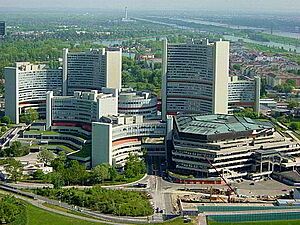
Many cities around the world wanted to host the UN Headquarters. These included Vienna, Berlin, and Philadelphia. By December 1945, the delegation decided on a headquarters in the United States.
In 1946, John D. Rockefeller Jr. offered to donate land along the East River in New York City. The UN chose this site over other locations. Before the current headquarters was finished, the UN used parts of a factory in Lake Success, New York. The General Assembly also met at the New York City Pavilion in Flushing Meadows.
The UN headquarters officially opened on January 9, 1951. Construction was fully completed on October 9, 1952.
How the UN is Organized
The basic way the United Nations is set up has not changed much. However, many more countries have joined, which has affected how some parts work. Over the years, the UN has also created many other groups and organizations. Some focus on specific regions, others on peacekeeping missions, and some have a global reach. Other important groups, like the International Labour Organization, existed before the UN and later joined forces with it.
Important Moments for the UN
- In October 2015, over 350 famous landmarks in 60 countries were lit in blue. This celebrated the 70th anniversary of the United Nations.
See also
- Diplomatic history of World War II
- Foreign policy of the Franklin D. Roosevelt administration § Founding the United Nations
- Foreign policy of the Harry S. Truman administration § United Nations
- Growth in United Nations membership
- List of members of the United Nations Security Council
- List of vetoed United Nations Security Council resolutions by all countries
- Reform of the United Nations
- Timeline of UN peacekeeping missions
- List of UN Secretaries-General
- United States and the United Nations


